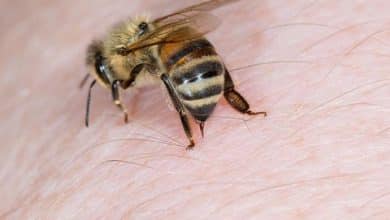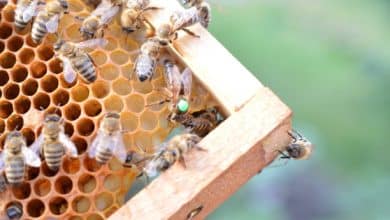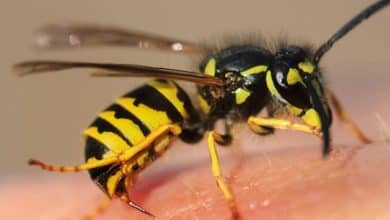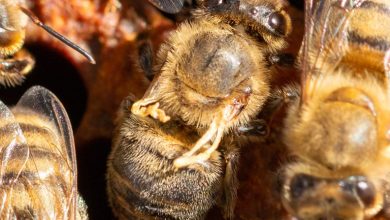Effective Strategies for Varroa Mite Treatment in Beekeeping

Varroa Mite Treatment are a common and significant threat to honeybee colonies in beekeeping operations. These parasitic mites feed on the bodily fluids of adult bees and their developing brood, weakening the bees and potentially leading to colony collapse. Therefore, understanding the biology and impact of Varroa mites is essential for effective beekeeping practices.
Varroa mites have a complex life cycle that involves reproducing inside the sealed brood cells. They can reproduce rapidly and multiply in numbers, causing immense damage to the bee colony. These mites not only weaken the adult bees but also transmit viral diseases, further compromising the health of the colony. If left untreated, Varroa mite infestations can lead to the decline and eventual death of the bees.
To mitigate the impact of Varroa mite infestations, beekeepers use various detection and monitoring techniques. Regular inspections of the hive, particularly during brood rearing periods, help identify mite infestations and determine the severity of the problem. Tools such as sticky boards and alcohol washes can be used to collect and count mites, providing valuable information for treatment decisions.
Chemical treatments, both synthetic acaricides and organic options, are commonly used for Varroa mite control. Synthetic acaricides are effective, but their repeated use can lead to mite resistance. Organic options, such as essential oils and formic acid, offer alternative methods for treatment. Integrated Pest Management (IPM) approaches, combining cultural and biological control methods, are also effective in managing Varroa mites.
Hive management practices, such as maintaining hive hygiene and disrupting the brood cycle, are important in combating Varroa mites. Regularly cleaning and replacing hive materials, as well as selecting and rearing resistant queen bees, can help reduce mite infestation rates and improve overall colony health.
In conclusion, understanding the biology and impact of Varroa mites is crucial for effective Varroa mite treatment in beekeeping. By using a combination of detection techniques, chemical treatments, integrated pest management approaches, and good hive management practices, beekeepers can effectively control Varroa mite populations and ensure the health and longevity of their honeybee colonies.
Varroa Mite Biology and Impact on Honeybee Colonies
Varroa mites, scientifically known as Varroa destructor, are external parasites that have a devastating impact on honeybee colonies. These tiny mites attach themselves to adult bees and their brood, feeding on their bodily fluids. As they feed, the mites weaken the bees, causing reduced lifespan, impaired immune systems, and decreased brood production.
One of the most concerning aspects of Varroa mites is their ability to transmit viral diseases to the bees. These viruses, such as Deformed Wing Virus and Bee Paralysis Virus, can lead to various deformities and health issues in the bees, ultimately resulting in colony decline. In fact, many bee colony losses can be attributed to the presence of Varroa mites and the subsequent viral infections.
The life cycle of Varroa mites is closely intertwined with that of the honeybees. The mites reproduce in sealed brood cells, with the female mite entering the cell to lay her eggs. As the bees develop, the mites also thrive, multiplying rapidly and infesting the entire colony if left unchecked.
The impact of Varroa mites on honeybee colonies extends beyond individual bees. Infested colonies often experience reduced honey production, weakened immune systems, and increased susceptibility to other pests and diseases. If not properly managed, Varroa mite infestations can lead to colony collapse, endangering the entire hive.
Therefore, it is crucial for beekeepers to implement effective Varroa mite treatment strategies to protect their honeybee colonies. By understanding the biology and impact of Varroa mites, beekeepers can make informed decisions to mitigate the damage caused by these parasites and ensure the survival and productivity of their hives.
Varroa Mite Detection and Monitoring Techniques
Varroa mite detection and monitoring are essential aspects of effective varroa mite treatment in beekeeping. By regularly assessing the mite infestation levels, beekeepers can make informed decisions about the appropriate treatment methods and timing.
There are several techniques available for detecting and monitoring varroa mites in honeybee colonies. One common method is the use of sticky boards or sticky inserts placed on the bottom board of the hive. These sticky surfaces trap the mites as they fall from the bees. By periodically collecting and counting the mites on the sticky boards, beekeepers can estimate the mite population and monitor their levels over time.
Another technique is alcohol wash or sugar shake method, which involves collecting a sample of bees and shaking them in either alcohol or powdered sugar. The mites dislodge from the bees and can be counted and assessed. This method provides a more accurate estimation of the mite infestation, as it directly samples the mites present on the bees.
Beekeepers can also use the natural mite drop method, where mites falling from the bees are collected and counted over a specific period. This method requires the use of screened bottom boards that allow the mites to fall away from the colony. Periodic monitoring of the mite drop can provide valuable insight into the mite infestation levels.
Furthermore, advanced technologies such as the use of varroa mite detection devices have emerged in recent years. These devices utilize infrared sensors or other mechanisms to detect and count mites non-invasively. They provide real-time data on mite infestation and can help beekeepers make timely treatment decisions.
In conclusion, regular detection and monitoring of varroa mites are crucial for effective treatment and control. By using techniques such as sticky boards, alcohol wash, natural mite drop, and advanced detection devices, beekeepers can accurately assess mite infestation levels and take necessary steps to protect their colonies.
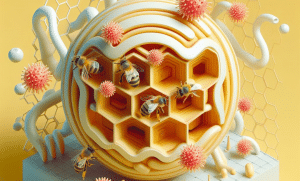
Chemical Treatments for Varroa Mite Control
Chemical treatments are a widely used method for controlling varroa mites in beekeeping. These treatments involve the application of synthetic acaricides or chemical substances specifically designed to target and kill varroa mites. While chemical treatments can be effective in reducing mite populations, it is important to use them judiciously and according to label instructions to minimize any potential negative effects on bees and the environment.
One commonly used chemical treatment is formic acid. This treatment has been approved by the Environmental Protection Agency (EPA) for varroa mite control in the United States. Formic acid has been used by beekeepers in Canada and Europe for many years and is the only chemical pesticide that can be used for organic honey production. However, it is important to note that formic acid may not completely eliminate mite populations on its own. It is often used in combination with other control methods such as screened bottom boards to increase mite drop.
Another chemical treatment option is synthetic acaricides, such as fluvalinate and coumaphos. These chemicals are effective in killing varroa mites but should be used with caution. Overuse or incorrect application of synthetic acaricides can lead to resistance development in mites and the potential for residues in honey.
When using chemical treatments, it is crucial to follow the recommended dosage and application instructions provided by the manufacturers. It is also important to consider the timing of treatment to target mites during their vulnerable life stages. Regular monitoring and periodical rotation of different chemicals can help prevent mite resistance development.
In conclusion, chemical treatments can be an effective tool in managing varroa mite infestations in beekeeping. However, it is important to use them responsibly, following label instructions and considering their potential impacts on bees and the environment. Integrated approaches that combine chemical treatments with other control methods can provide more effective and sustainable varroa mite control in beekeeping operations.
Synthetic Acaricides for Varroa Mite Treatment
There are several synthetic acaricides available for Varroa Mite Treatment in beekeeping. These chemical compounds are specifically designed to target and kill varroa mites, helping to reduce their populations within honeybee colonies. However, it is important to use these synthetic acaricides judiciously and according to label instructions to minimize any potential negative effects on bees and the environment.
Two commonly used synthetic acaricides for Varroa Mite Treatment are coumaphos and fluvalinate. These chemicals work by interfering with the nervous system of the mites, ultimately leading to their death. Coumaphos is available in different forms, including strips, dusts, and grease patties, which can be placed in beehives. Fluvalinate is typically applied as a strip or a liquid solution.
While these synthetic acaricides can be effective in reducing varroa mite populations, it is important to rotate between different chemical treatments to prevent mite resistance from developing. Overuse or incorrect application of these chemicals can also lead to residues in honey, so it is crucial to follow the recommended dosage and application instructions provided by the manufacturers.
In some cases, varroa mites may also develop resistance to certain synthetic acaricides. This highlights the importance of using integrated pest management strategies, which combine different control methods and minimize reliance on synthetic chemicals alone. By incorporating other control methods such as cultural practices, biological controls, and natural remedies, beekeepers can improve the effectiveness and sustainability of Varroa Mite Treatment.
In conclusion, synthetic acaricides are commonly used for Varroa Mite Treatment in beekeeping. However, their use should be accompanied by careful management practices and consideration of alternative control methods. By taking an integrated approach to Varroa Mite Treatment, beekeepers can maintain healthy honeybee colonies while minimizing the potential negative impacts on bees and the environment.
Organic Varroa Mite Control Options
Organic varroa mite control options offer beekeepers a natural and environmentally friendly alternative to synthetic chemical treatments. These methods focus on utilizing organic substances and biological controls to manage varroa mite infestations in honeybee colonies.
One organic option is the use of essential oils. Oils such as thymol, wintergreen, and eucalyptus have been found to have acaricidal properties that can effectively kill varroa mites. These oils can be applied as a fumigant or in vapor form within the beehive. However, it is important to note that essential oils can also affect the bees, so it is crucial to follow recommended application rates to avoid any negative effects.
Another organic control method is the use of organic acids, such as formic acid and oxalic acid. These acids can be applied as a liquid solution or a vapor treatment. Organic acids work by disrupting the mite’s physiological processes and causing their death. Like essential oils, organic acids should be used with caution and in accordance with recommended dosage rates to ensure the safety of the bees.
While organic varroa mite control options can be effective, it is important to remember that they may not provide complete eradication of mites. These methods are best used as part of an integrated pest management approach, combined with other control methods and regular monitoring. Additionally, it is crucial to follow organic certification guidelines if maintaining organic status is a priority for beekeepers.
In conclusion, organic varroa mite control options offer a natural and environmentally friendly approach to managing mite infestations in beekeeping. Essential oils and organic acids can be effective in reducing mite populations, but they should be used judiciously and in combination with other control methods for optimal results. By incorporating organic options into their varroa mite treatment plans, beekeepers can promote the health and sustainability of their honeybee colonies.
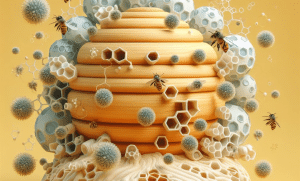
Integrated Pest Management (IPM) Approaches
Integrated Pest Management (IPM) is a holistic approach to pest control that aims to manage varroa mite infestations in beekeeping while minimizing harm to the environment and honeybee colonies. This approach incorporates multiple strategies and techniques to prevent and mitigate mite populations, reducing the dependence on chemical treatments. IPM focuses on long-term, sustainable management rather than relying solely on synthetic acaricides.
One key principle of IPM is monitoring and detection. Regular monitoring of varroa mite levels allows beekeepers to assess the severity of infestations and determine the appropriate treatment measures. Various techniques, such as sugar shaking, sticky boards, drone brood inspection, and alcohol washes, can be used to monitor mite populations.
In IPM, cultural control methods play a crucial role. These practices include the use of screened bottom boards to promote mite fall, drone brood removal to disrupt mite reproduction, and splitting colonies to interrupt mite reproduction cycles. By implementing these cultural practices, beekeepers can reduce mite numbers without relying solely on chemical treatments.
Biological control methods are also integrated into IPM approaches. These may involve the use of natural predators, such as predatory mites, or the introduction of resistant honeybee strains that can better tolerate varroa mite infestations. Additionally, hygienic behavior breeding programs, which focus on selecting and breeding honeybees that exhibit hygienic behavior towards mites, can also be an effective biological control strategy.
By combining these different control methods, beekeepers can effectively manage varroa mite infestations while minimizing the negative impacts on honeybee colonies and the environment. It is important for beekeepers to stay informed about the latest research and advancements in IPM strategies to continually improve their varroa mite management practices.
IPM Strategies for Varroa Mite Management
Integrated Pest Management (IPM) is an effective approach to managing varroa mite infestations in beekeeping. IPM strategies for varroa mite management involve a combination of cultural, biological, and chemical control methods. These methods work together to reduce mite populations and prevent the spread of infestations without relying solely on chemical treatments.
One key IPM strategy is regular monitoring and detection of varroa mite levels. Beekeepers can use various techniques, such as sugar shaking, sticky boards, and alcohol washes, to assess the severity of infestations. This allows them to determine the appropriate treatment measures and track the effectiveness of their control methods.
Cultural control methods also play an important role in an IPM approach. Practices like using screened bottom boards can promote mite fall, while removing drone brood disrupts mite reproduction. Splitting colonies can also help interrupt mite reproduction cycles. These cultural practices help reduce mite numbers naturally, minimizing the need for chemical treatments.
Biological control methods are integrated into IPM strategies as well. This may involve the use of natural predators, such as predatory mites, or the introduction of varroa-resistant honeybee strains. Breeding programs that focus on selecting and breeding bees with hygienic behavior towards mites are also effective biological control strategies.
By combining these different control methods, beekeepers can effectively manage varroa mite infestations while minimizing the negative impacts on honeybee colonies and the environment. It is important for beekeepers to stay informed about the latest research and advancements in IPM strategies to continually improve their varroa mite management practices. Implementing IPM strategies not only helps protect honeybee colonies, but also promotes the long-term sustainability of beekeeping.
Combining Cultural and Biological Control Methods
Combining cultural and biological control methods is a powerful approach in the management of varroa mites in beekeeping. By integrating these two methods, beekeepers can effectively reduce varroa mite populations and minimize the reliance on chemical treatments for control.
Cultural control methods involve implementing practices that disrupt the reproduction and survival of varroa mites. One effective cultural method is the removal of drone brood. Varroa mites prefer to reproduce in drone brood cells, so removing these cells can significantly reduce mite numbers. Additionally, splitting colonies can help interrupt the mite reproduction cycle by separating infested colonies and preventing the spread of mites. Using screened bottom boards can also promote mite fall and decrease mite populations within the hive.
Biological control methods, on the other hand, utilize natural enemies or varroa-resistant honeybee strains to suppress mite populations. Predatory mites, such as Stratiolaelaps scimitus, can be introduced to the hive to prey on varroa mites. These predatory mites feed on both adult and immature mites, helping to control their numbers. Beekeepers can also select and breed honeybees with traits that exhibit resistance to varroa mites, such as hygienic behavior, which involves the removal of mite-infested brood cells.
By combining cultural and biological control methods, beekeepers can create a comprehensive approach to varroa mite management. This integrated strategy can lead to more sustainable and effective control outcomes by reducing mite populations and preventing the development of resistance to chemical treatments. It is important for beekeepers to regularly monitor and evaluate the effectiveness of these control methods to adjust their management strategies accordingly. Implementing cultural and biological control methods not only helps protect honeybee colonies from varroa mite infestations but also contributes to the overall health and sustainability of beekeeping practices.

Essential Oils and Natural Remedies for Varroa Mite Treatment
Essential oils and other natural remedies have gained attention in recent years as potential treatments for varroa mite infestations in beekeeping. These alternatives to chemical pesticides offer a more natural and environmentally friendly approach to varroa mite control.
One of the most popular essential oils used for varroa mite treatment is thymol, which is derived from the thyme plant. Thymol has shown promising results in controlling varroa mite populations. It works by disrupting the mites’ respiratory system, leading to their eventual death. Thymol is typically applied in the form of strips or pads placed inside the beehive. Beekeepers should follow the manufacturer’s instructions for proper dosage and application methods to ensure effectiveness and safety.
Another natural remedy that has been explored for varroa mite treatment is formic acid. This acid occurs naturally in beeswax and is also found in certain plants. Formic acid is highly toxic to varroa mites, causing damage to their exoskeleton and respiratory system. It can be applied through various methods, such as vaporization or using formic acid pads. However, it is important to note that formic acid can be harmful to bees if not used correctly, so proper dosage and application techniques are crucial.
In addition to essential oils and formic acid, beekeepers have also experimented with other natural treatments, such as oxalic acid and powdered sugar dusting. Oxalic acid, when used properly, can effectively kill varroa mites without causing harm to bees. Dusting the bees with powdered sugar can help dislodge mites from their bodies, reducing their population within the colony.
It is important for beekeepers to remember that natural remedies may not provide complete eradication of varroa mites and may need to be used in combination with other control methods. Regular monitoring of mite populations and evaluation of treatment effectiveness are essential for successful varroa mite management. By incorporating essential oils and natural remedies into their varroa mite treatment strategies, beekeepers can reduce their reliance on chemical pesticides and promote the health and sustainability of honeybee colonies.
Efficacy of Essential Oils in Varroa Mite Control
Essential oils have gained popularity as a natural and alternative treatment for controlling Varroa mites in beekeeping. One of the most widely used essential oils for this purpose is thymol, derived from the thyme plant. Thymol has shown promising efficacy in controlling Varroa mite populations in beehives. When applied correctly, thymol disrupts the mites’ respiratory system, leading to their eventual demise. However, it is important to note that thymol treatment may not be effective in controlling mites within brood cells, as it cannot penetrate the cell cappings.
In addition to thymol, other essential oils have also been explored for Varroa mite control. Oils such as wintergreen, eucalyptus, and tea tree oil have demonstrated varying levels of efficacy against Varroa mites. These oils contain compounds that are toxic to the mites and can cause damage to their exoskeleton and respiratory system.
It is important to consider the dosage and application methods when using essential oils for Varroa mite control. Proper dosage ensures maximum effectiveness while minimizing potential harm to the bees. Many beekeepers use essential oils in the form of strips or pads placed inside the beehive, following the manufacturer’s instructions for the specific product.
While essential oils can be effective in reducing Varroa mite populations, it is important to note that they may not provide complete eradication. Therefore, regular monitoring of mite populations and evaluation of treatment effectiveness are essential for successful Varroa mite management.
By incorporating essential oils into their Varroa mite treatment strategies, beekeepers can reduce their reliance on chemical pesticides and promote the health and sustainability of honeybee colonies. However, it is important to continue researching and exploring new treatment options to stay ahead of Varroa mite resistance and ensure the long-term success of beekeeping.
Using Formic Acid and Other Natural Treatments
Formic acid is a commonly used natural treatment for Varroa mite control in beekeeping. It has shown to be effective in killing Varroa mites while being minimally invasive to honey bee colonies. This treatment involves brushing the capped brood with formic acid, which penetrates through the cell caps and reaches the mites hiding within the brood cells.
Studies have shown that formic acid treatment can significantly reduce Varroa mite infestations and improve the overall health of honeybee colonies [22]. The acidic nature of formic acid disrupts the respiratory system of the mites, leading to their demise. It is important to note that formic acid can also have an impact on the honeybees, so proper dosage and application methods are crucial for minimizing harm.
In addition to formic acid, there are other natural treatments that beekeepers can consider for Varroa mite control. These include oxalic acid, which can be applied as a spray or in vapor form. Oxalic acid treatment has shown effectiveness in reducing Varroa mite populations, especially during the broodless period when the mites are most vulnerable.
Another natural treatment option is powdered sugar dusting. This involves dusting the bees with powdered sugar, which causes the mites to lose their grip on the bees’ bodies due to the sticky nature of the sugar. This method is less invasive and can provide some level of mite control, although it may not be as effective as other treatments.
It is important for beekeepers to carefully consider the dosage and application methods of these natural treatments to ensure their effectiveness and minimize any potential negative effects on the bees. Regular monitoring of mite populations and evaluation of treatment effectiveness are also important for successful Varroa mite management.
By incorporating natural treatments like formic acid, oxalic acid, and powdered sugar dusting into their Varroa mite control strategies, beekeepers can reduce their reliance on chemical pesticides and promote the health and sustainability of honeybee colonies. However, it is important to continue researching and exploring new treatment options to stay ahead of Varroa mite resistance and ensure the long-term success of beekeeping.

Hive Management Practices to Combat Varroa Mites
Hive management practices play a crucial role in combating Varroa mites and maintaining healthy honeybee colonies. By implementing effective hive management strategies, beekeepers can minimize the impact of Varroa mites and contribute to the overall health and survival of their bees.
- Hive Hygiene: Maintaining a clean and hygienic hive environment is essential for controlling Varroa mite infestations. Regularly inspect the hive for signs of mites, such as deformed wing virus (DWV) symptoms or mite droppings, and take appropriate action if necessary. Removing debris and keeping the hive clean can help reduce mite populations and prevent their spread.
- Beekeeping Best Practices: Following recommended beekeeping practices can help prevent or minimize Varroa mite infestations. This includes providing adequate nutrition for bees, ensuring proper ventilation in the hive, and regularly monitoring and evaluating the health and behavior of the colony. Strong and healthy colonies are better equipped to resist and recover from Varroa mite infestations.
- Queen Selection and Brood Cycle Disruption: Selecting and breeding resistant or tolerant queen bees can significantly contribute to Varroa mite management. Some honeybee breeds or strains exhibit natural resistance to Varroa mites, and beekeepers can selectively breed these traits into their colonies. Additionally, disrupting the brood cycle by splitting or requeening can temporarily interrupt the mite’s reproductive cycle, reducing their population.
- Integrated Pest Management (IPM) Strategies: Implementing integrated pest management approaches can help reduce Varroa mite populations. This involves using a combination of cultural, biological, and chemical control methods to target mites at different stages of their life cycle. Rotating treatments and avoiding over-reliance on a single method can reduce the risk of mite resistance.
By incorporating these hive management practices into their beekeeping routines, beekeepers can effectively combat Varroa mites and improve the long-term health and productivity of their honeybee colonies. It is important to stay informed about new research and management techniques to stay ahead of the challenges posed by Varroa mites and ensure the sustainability of beekeeping practices.
Hive Hygiene and Beekeeping Best Practices
Maintaining a clean and hygienic hive environment is crucial in combating Varroa mites and promoting the overall health of honeybee colonies. Beekeepers should prioritize hive hygiene as part of their beekeeping best practices.
Regularly inspecting the hive for signs of mites, such as deformed wing virus (DWV) symptoms or mite droppings, is essential for early detection and intervention. Upon detecting mite infestations, appropriate action should be taken promptly to prevent the spread and proliferation of mites within the colony.
Keeping the hive clean and free from debris is important for reducing mite populations. Regularly removing old comb and replacing it with fresh comb can help minimize mite infestations, as mites tend to accumulate in old comb.
In addition, maintaining proper ventilation in the hive is crucial. Good ventilation promotes airflow and helps remove excess moisture, which can create a favorable environment for mite reproduction. Adequate airflow can also assist in diminishing the mite population.
Beekeepers should also ensure that their colonies have access to an adequate and balanced diet. Providing proper nutrition strengthens the bees’ immune systems, making them more resilient against mite infestations.
Regularly monitoring and evaluating the health and behavior of the colony is another important practice. This allows beekeepers to identify early signs of mite infestations and take appropriate measures to address the issue promptly.
By implementing these hive hygiene and beekeeping best practices, beekeepers can significantly reduce the impact of Varroa mites and maintain healthier honeybee colonies. Consistency and attention to detail are key in preventing and managing mite infestations effectively.
Queen Selection and Brood Cycle Disruption
Queen selection and brood cycle disruption are two effective strategies to control Varroa mite infestations in honeybee colonies.
Choosing a high-quality queen is crucial for maintaining a strong and healthy colony. Beekeepers should select queens that have shown resistance to Varroa mites and have the ability to lay a high number of worker eggs. These queens will produce a productive and robust workforce that can help in reducing mite populations. Regularly replacing queens with new ones is also recommended, as it prevents the buildup of mites that may have developed resistance to previous treatments.
Brood cycle disruption is another technique that can be employed to control Varroa mites. By interrupting the brood cycle, beekeepers can break the reproduction cycle of the mites and reduce their population. This can be achieved by removing drone brood, as Varroa mites prefer to reproduce in drone cells. Using techniques such as queen caging or trapping comb can also temporarily disrupt the brood cycle and limit mite reproduction.
Combining queen selection and brood cycle disruption techniques can yield even better results in controlling Varroa mites. By selecting resistant queens and periodically disrupting the brood cycle, beekeepers can effectively manage mite populations and reduce the spread of diseases associated with Varroa mites.
Implementing these strategies as part of integrated pest management approaches can significantly improve the health and survival of honeybee colonies. However, it is important to regularly monitor and evaluate the colony’s health to ensure the effectiveness of these techniques. The ultimate goal is to maintain strong and productive colonies while minimizing the impact of Varroa mite infestations.

In conclusion, effective varroa mite treatment is essential for maintaining healthy honeybee colonies and ensuring the long-term sustainability of beekeeping operations. Varroa mites pose a serious threat to honeybees, causing significant damage to their health and productivity. However, with the right strategies and techniques, beekeepers can successfully manage and control varroa mite infestations.
Chemical treatments, such as synthetic acaricides and organic options, can be effective in reducing varroa mite populations. Integrated pest management (IPM) approaches that combine cultural and biological control methods provide a holistic and sustainable approach to varroa mite management. Regular monitoring and detection techniques are crucial for early intervention and treatment.
In addition, natural remedies like essential oils and formic acid have shown promise in controlling varroa mites while minimizing the impact on honeybee colonies. Hive management practices, such as maintaining proper hygiene and selecting resistant queens, play a vital role in managing varroa mite infestations.
Overall, it is important for beekeepers to prioritize varroa mite treatment as part of their beekeeping practices. Regular inspections, monitoring, and implementing appropriate treatment measures are key to successfully controlling varroa mite populations and preserving honeybee health.
Further research and development in Varroa Mite Treatment control strategies are needed to address emerging challenges and optimize treatment methods. By continuously improving our understanding of Varroa Mite Treatment and developing effective treatment options, we can safeguard honeybee colonies and ensure the sustainability of beekeeping for future generations.
Importance of Varroa Mite Treatment in Beekeeping
Effective varroa mite treatment is of utmost importance in beekeeping for the health and survival of honeybee colonies. Varroa mites are a major threat to the beekeeping industry, as they feed on the hemolymph of bees and transmit various viruses, weakening the bees’ immune system and causing significant damage to the colony.
Without proper treatment, varroa mite infestations can lead to weakened and ultimately collapsed colonies. This not only affects honey production but also poses a threat to the pollination services that honeybees provide to countless agricultural crops.
Controlling varroa mites is crucial for maintaining the overall sustainability of beekeeping operations. By implementing effective treatment strategies, beekeepers can prevent the spread of mites within their colonies and reduce the negative impacts on bee health.
Regular monitoring and early detection of varroa mite infestations are key to successful treatment. This allows beekeepers to intervene and implement the necessary treatment measures before the mite population becomes overwhelming.
By treating varroa mites, beekeepers can help ensure the long-term viability of their colonies and increase the chances of overwintering success. This is particularly important for commercial beekeepers who rely on healthy colonies for honey production and pollination services.
Furthermore, by actively controlling varroa mites, beekeepers contribute to the overall health and well-being of honeybees globally. Varroa mite control is a collective responsibility that helps protect the essential role that honeybees play in agriculture and biodiversity.
In conclusion, varroa mite treatment is not just a task but a vital responsibility for beekeepers. Through early detection, monitoring, and proper treatment strategies, beekeepers can safeguard their colonies and contribute to the sustainability of the beekeeping industry as a whole.
Future Directions in Varroa Mite Research and Control
As the threat of varroa mites continues to loom over honeybee colonies, researchers and beekeepers alike are actively exploring future directions in varroa mite research and control. With the goal of finding more effective and sustainable methods, these efforts aim to mitigate the devastating impact of varroa mite infestations on bee populations.
One area of focus is the development of alternative treatments and management strategies. This includes investigating the use of genetic tools to breed honeybees with enhanced resistance to varroa mites. By identifying and selecting individuals with natural resistance traits, researchers hope to establish mite-resistant honeybee populations that can better withstand infestations.
Furthermore, ongoing research is exploring the use of biological control agents, such as predatory mites and fungi, to tackle varroa mite populations. These natural enemies can potentially provide a more environmentally friendly and sustainable approach to mite control. Additionally, scientists are exploring the use of RNA interference (RNAi) technology to target and disrupt varroa mite genes, thereby reducing their ability to reproduce and harm honeybees.
Advancements in technology and data analysis are also shaping the future of varroa mite research. Researchers are utilizing high-throughput sequencing techniques to gain a deeper understanding of varroa mite biology and its interaction with honeybees. This knowledge can inform the development of more targeted and precise treatment strategies.
Collaboration among researchers, beekeepers, and industry stakeholders is crucial for advancing varroa mite research and control. By pooling resources and knowledge, we can work towards the shared goal of finding sustainable and effective solutions to mitigate the impact of varroa mites on honeybee populations.
In conclusion, the future of varroa mite research and control holds promise for the honeybee industry. Through genetic selection, biological control methods, technological advancements, and collaborative efforts, we can strive towards a world where honeybee colonies can thrive without the constant threat of varroa mite infestations.
Thank you for taking the time to learn about effective strategies for varroa mite treatment in beekeeping. It’s important to stay informed and proactive in order to protect our precious honey bee colonies. If you have any questions or additional insights to share, please feel free to reach out. Together, we can work towards a healthier and thriving beekeeping community.




